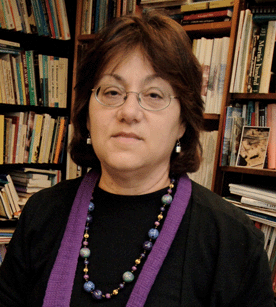A Stitch in Time
CAS archaeologist finds meaning in thimbles, bodkins, and other sewing tools

For nearly two decades, archaeologist Mary Beaudry painstakingly excavated the grounds of a 17th-century farmhouse in Newbury, Mass., uncovering clues to the changing family life in New England. Much of her research focused on the merchants and farmers who had owned the 1690 Spencer-Peirce-Little House. Animal bones and plant remains dating to 1788 revealed the menu of a fancy dinner hosted by the farm’s well-to-do owner. The broken bottles found along a fence line, most of which had held hair restorers and dye, suggested that one 19th-century occupant was more than a little concerned about his appearance.
But an inscribed silver thimble, unearthed by one of her volunteers in 1992, was different. “It was very feminine-looking,” says Beaudry, a College of Arts and Sciences professor of archaeology. “It was engraved, and it must have been really important, something somebody didn’t want to lose.” The thimble set her on a new course — to learn more about the women of the Spencer-Peirce-Little House and eventually to write a book, Findings: The Material Culture of Needlework and Sewing (Yale University Press, 2007), in which she identifies and interprets sewing implements that archaeologists commonly find and typically ignore.
Beaudry herself hadn’t paid much attention to the various thimbles, hem weights, lace bobbins, and straight pins that she and her students had dug up while working at the farm from 1986 to 2004. “I had fallen into the trap nearly all archaeologists do, that pins equal sewing,” she says. “They don’t.”
A closer inspection of these artifacts, she says, can reveal what kind of needlework was being done — utilitarian, such as sewing or mending, or decorative, such as embroidery — and whether the items were for household use or for sale. It also can help paint a broader picture about their owners’ economic and social status.
Straight pins in the 17th and 18th centuries had many purposes beyond holding together fabric to be sewed. They were used to fasten the pages of a document, the folds of a blanket, and all manner of clothing, from diapers and breeches to veils and ruffs. To be sure, needles were used for sewing, embroidery, and tapestry, but there also were many types of specialty implements, including glover’s, upholsterer’s, milliner’s, collar, carpet, matting, packing, and culinary needles.
“The thimble got me going in the first place, but so did the idea that small finds could be informative, including silly little things like straight pins,” Beaudry says. “So I kept trying to figure out how to look at them and realized that you could tell roughly what they were intended for. And archaeologists had never really done that before. They had found big pins and called them hat pins. But when you’re digging at a colonial site and you know anything about what kind of hats women were wearing, it’s not a hat pin. Just a little bit of looking can tell you a lot, and the same was true of thimbles and needles.”
Take the bodkin, a straight, flat needle used by both men and women to thread ribbons and cords, but most often employed by women to lace up their corsets or bodices. Among the bodkins Beaudry is researching is a late-17th-century silver needle with the initials E.I. or E.J., found in the soil at Boston’s Mill Pond. “It is evident that women in early Boston, like women elsewhere, treasured their bodkins enough to personalize them and probably used them in social display,” Beaudry writes in her book. Indeed, after lacing up, a woman might tuck the bodkin into her coif, like so much colonial bling. “They signaled all kinds of social status,” says Beaudry.
She points to the widow of John How of Ipswich, Mass., who was called into court in 1663 for wearing a silver bodkin in her silk scarf. At the time, the poor were forbidden to dress ostentatiously. The Widow How’s accusers likely assumed — wrongly, it turns out — that she had fallen on hard times when her husband died, says Beaudry, and they believed that the highly valued bodkin did not befit her new status.
“I’m trying to talk about the emotional aspects of these objects,” Beaudry says. “I find that they are not just about feminine identity, but about individual identity, and that’s what has really caught my interest.”
Beaudry also wants to separate by date the sewing implements dug up at the Spencer-Peirce-Little House and relate them to the women from successive households. She hasn’t found the owner of the silver thimble; none of the occupants had the initials L.W.B. “We know that in the 19th and early 20th centuries, the ladies who lived there had sewing circles,” she says, “and of course they had cousins and aunts who would be sewing there, possibly losing their thimbles.”
One of the difficulties is that, unlike the male homeowners, women rarely show up in historical records. “Whether the artifacts will inform me about their lives in a way that is richly satisfying, I’m not sure,” Beaudry says. “And I’m not sure that needs to happen. It’s forced me to bring them into the picture.”
Cynthia K. Buccini can be reached at cbuccini@bu.edu.
Comments & Discussion
Boston University moderates comments to facilitate an informed, substantive, civil conversation. Abusive, profane, self-promotional, misleading, incoherent or off-topic comments will be rejected. Moderators are staffed during regular business hours (EST) and can only accept comments written in English. Statistics or facts must include a citation or a link to the citation.